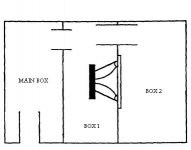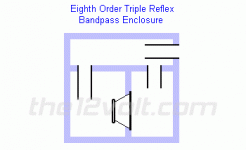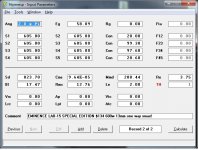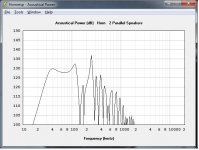While on the subject (of modifying traditional bandpass boxes by adding some quarter wave action to improve performance), I have been thinking it would be fun at some point to attempt an 8th order hybrid with the additional resonance falling between 1.5x and 2x FB because it would really help to control the bump in excursion above FB and would allow great output even when using drivers with less xmax like the Definimax 4012ho ..... Just thought .... I know some others discussed it (like Patrick Bateman i think?) on this site but as far as i know nobody was yet able to come up with anything practical yet, seems like a valid concept though .....
Using these in a club would work if you had enough boxes to pressurize the space properly ... You could even use the Geddes approach and arrange the cabs in different parts of the room to even out the response throughout the space and have more consistent bass no matter where a person is standing , but that would likely require some experimentation with placement ..
Yeah clubs don't like you messing up the decor and running long speaker wires (unless you're the manager and have the time to tear out walls this is a no go unfortunately. Much easier to just replace their subs where they have them, or find an unused corner and stand them upside down with mouths togther.
I imagine that these cabinets would not have the uber punchy midbass sound (apparent loudness) that people normally associate with PA bass cabinets, but a moreso hi-fi sound with a nice full bottom end ..
I made another sketch for you showing the differences between what i have simulated , you can see we are basically making equivalents to bandpass cabinets but working in some quarter wave action to benefit from the higher efficiency and increased bandwidth of using this type of loading... The plenum/bandpass (smaller chamber) resonant frequency is easier to predict with the parallel (compound pipe) version. ... These are 40hz versions just for example but of course you would want to scale up if needing a 35hz FB, however some of these sims show that even with the 40hz tuned cabs 35hz is only 3db down (excursion is exceeded below that at full power though) ...
For the sake of this comparison I made them similar in size with the larger cab being only slightly taller but I think that the compound version made even taller (longer path) simmed a little better with flatter response up into the midbass , however this makes the cab less deep so the plenum (small bandpass chamber) will be tuned too high to be effective, so some mass loading like what you saw in the compound scoop pictures i posted earlier would be required to bring that resonance back into the proper range .. Its easy enough to achieve, you just add a plate mounted in front of the small chamber with a constriction .. Easy to sim too ..
By the way Saba , have you seen the special run of LAB15 drivers that people have been talking about here on DIYaudio? They are very affordable and look like they might have the specs that would work well in some larger 35hz hybrid cabs, not as portable but perfect for permanent install situations ..... I will have to sim some of those special Labs to see how they look ...
Anyhow , I still don't know what to call these things but if your prototype works well enough to make you happy i suppose we will have to come up with something catchy
Let me know if you sim up a lab 15 version of the same thing I'm building now, could be a tempting design, but these are so space efficient that for my first purpose (subs for my friend to DJ with) they make the better choice. Down the road a couple months I may scale up to larger drivers if I can get more output per cubic foot with them. Right now the 500 watt alpine has ridiculous simulated output for its footprint so for now that's what I'm aiming to use.
What would an 8th order design look like?
The Karlson K15 is 8th order.
GM
Saba, to answer your question about what an 8th order can look like , here are two types in pure helmholtz mode (attached) , but something like this can be arranged in any number of ways as Freddi and XRK pointed out even some of the Karlson cabinets could be considered 8th order ...
The 8th order examples that i attached to this post have three resonances (one more than a helmholtz based 6th order)... The extra resonance can be really useful if properly spaced but of course tuning a box like this can be trickier, ironically designing in some quarter wave action by converting one of the sections into a tuned quarter wave pipe might make it easier to predict and work with and provide better output as well , but we wouldn't know for sure until someone gives it a shot ...
If i understand how they count up the orders correctly i believe the driver counts as two orders (even if one side fires into a sealed chamber) , and then every resonant section that is tuned to a different frequency is considered another two orders (so that means every chamber & port set in our Helmholtz mode example).... You could see these resonant sections as components that can be placed in either series or parallel but you have to be intuitive about how the sections will interact with one another ..... Series arrangements of resonant sections (end to end) can cut down on the size of the box because the lower frequencies can see the two sections combined as one big section (combined airspace, path length etc) yet the higher frequencies can see the sections as separate ... So in other words a single chamber or pipe can be made to serve double duty in a system like this.
If you want to keep the box size compact with the higher order boxes it will likely require drivers with high motor strength (or extension will be lost in an "overdamped" condition), the same phenomenon that is observed with the ABC/DCR variants but the results (if executed well) are more output, reduced excursion..... Other benefits are possible like group delay that is more evenly spread across the bass spectrum and a smoother roll-off on the bottom end that sounds more natural (ABC/DCR boxes can do this, i know this from personal experience) ..
There is a software called "Subwoofer Simulator" which can simulate 8th order helmholtz bandpass boxes of a single configuration .... I will attach that software file as well just in case somebody out there wants to experiment with 8th order simulations to get an idea of what they are all about ..
The 8th order examples that i attached to this post have three resonances (one more than a helmholtz based 6th order)... The extra resonance can be really useful if properly spaced but of course tuning a box like this can be trickier, ironically designing in some quarter wave action by converting one of the sections into a tuned quarter wave pipe might make it easier to predict and work with and provide better output as well , but we wouldn't know for sure until someone gives it a shot ...
If i understand how they count up the orders correctly i believe the driver counts as two orders (even if one side fires into a sealed chamber) , and then every resonant section that is tuned to a different frequency is considered another two orders (so that means every chamber & port set in our Helmholtz mode example).... You could see these resonant sections as components that can be placed in either series or parallel but you have to be intuitive about how the sections will interact with one another ..... Series arrangements of resonant sections (end to end) can cut down on the size of the box because the lower frequencies can see the two sections combined as one big section (combined airspace, path length etc) yet the higher frequencies can see the sections as separate ... So in other words a single chamber or pipe can be made to serve double duty in a system like this.
If you want to keep the box size compact with the higher order boxes it will likely require drivers with high motor strength (or extension will be lost in an "overdamped" condition), the same phenomenon that is observed with the ABC/DCR variants but the results (if executed well) are more output, reduced excursion..... Other benefits are possible like group delay that is more evenly spread across the bass spectrum and a smoother roll-off on the bottom end that sounds more natural (ABC/DCR boxes can do this, i know this from personal experience) ..
There is a software called "Subwoofer Simulator" which can simulate 8th order helmholtz bandpass boxes of a single configuration .... I will attach that software file as well just in case somebody out there wants to experiment with 8th order simulations to get an idea of what they are all about ..
Attachments
Freddi , to try to answer your question about drivers it seems that the following ranges work in this type of cabinet:
QTS between .4 and .6
VAS between 20 and 30 liters (can be in the higher end of this range if QTS is lower and vice-versa)
FS that equals or exceeds the FB
QMS is better if higher it seems
moving mass around 100g -ish or less ideally but we take what we can get..
XMAX should be 10mm (one way) for the 250w range , and at least 15mm for the 500w range.
Since Saba is going for an FB of 35hz it actually makes it a little easier to find drivers that will work because that is closer to the range of many car audio drivers ... The best thing to do if you think you have a driver that might work is to throw it into simulation and see how it looks ...
QTS between .4 and .6
VAS between 20 and 30 liters (can be in the higher end of this range if QTS is lower and vice-versa)
FS that equals or exceeds the FB
QMS is better if higher it seems
moving mass around 100g -ish or less ideally but we take what we can get..
XMAX should be 10mm (one way) for the 250w range , and at least 15mm for the 500w range.
Since Saba is going for an FB of 35hz it actually makes it a little easier to find drivers that will work because that is closer to the range of many car audio drivers ... The best thing to do if you think you have a driver that might work is to throw it into simulation and see how it looks ...
Last edited:
Drivers I've looked at list is pretty long at the moment, I'll save you the trouble: Eminence 3012LF is the best for a 40 Hz+ design per size (given you don't grow the cabinet besides to accomodate the driver), the two alpine drivers SWE10s4 and SWS 10d4 are the only two that I've found to sim nicely, read flat and without running out of excursion limiting your output severely, to 30-34 Hz in that size (or really any size +-25 percent). I've looked at a number of Eminence, MCM, auto sound (as a category), peerless, and a few other companies -> buy the sws10d4 if you're looking for a 10, I can only imagine what the alpine 12 would be like in an appropriately sized box.
Since i mentioned ABC/DCR alignments earlier i thought i might also throw THIS out there, it is a really interesting arrangement that employs a parasitic resonator... Many people that build this type of box may not realize that it adds quite a lot of damping and that the box needs to be bigger than a standard reflex box if using the same driver, however to get around this problem and to keep cabinet size down you can use a driver that has much more motor strength ... Something like one of the Soundqubed drivers would probably do the trick if you don't mind the foam surround ... They claim to have quite a bit of power handling for a low price ....
Output on these boxes is said to be pretty good , similar to a TL (qwp) but with better cone control ....
I have a weird old version of winISD that i can post here that simulates these types of cabinets if anyone wants to tinker with that ... Let me know ..
Output on these boxes is said to be pretty good , similar to a TL (qwp) but with better cone control ....
I have a weird old version of winISD that i can post here that simulates these types of cabinets if anyone wants to tinker with that ... Let me know ..
Attachments
Last edited:
in posts 51 and 56 you mentioned sims of single and dual driver designs that going to 300hz and you would post sketches. Did I miss them?
The cabinet sketches simpler designs in post 60 2nd attachment seem to be the same except for length but the helmholtz schematics are different. Are the boxes the same?
The cabinet sketches simpler designs in post 60 2nd attachment seem to be the same except for length but the helmholtz schematics are different. Are the boxes the same?
IMS , the hybrids in post 60 do look very similar, they are slightly different but it is subtle , take a closer look at how the constriction or port exits into the smaller chamber in one sketch and on the other sketch it exits out of the box ... The sketch on the left is a series alignment using the smaller chamber to do double duty (extends the path a little), while the sketch on the right is a parallel alignment and has to be made slightly larger....
The parallel approach might be better if you are trying to get up to 300 because it would be easier to predict that upper bandpass or plenum' resonant frequency which has to fall between the 3rd and 5th harmonic of the main pipe's output .....
Brian Steele had some success with getting the series version of something like this working in one of his tapped horn proof of concept boxes , he called it the "Dog Food Duct" or DFD , where he basically moved a constriction up and down the pipe until the dip above the 3rd harmonic filled in nicely , worked like a charm and extended his bandwidth and gave him more output at the high end while also seeming to add a damping effect to his cabinet smoothing out the bump at FB , and even lowered his FB by a few hertz! nice bonus ...... Pretty interesting stuff ...
Here is a link to that section on Brian's website:
The Subwoofer DIY Page v1.1 - Projects : "Proof of Concept #2"
The parallel approach might be better if you are trying to get up to 300 because it would be easier to predict that upper bandpass or plenum' resonant frequency which has to fall between the 3rd and 5th harmonic of the main pipe's output .....
Brian Steele had some success with getting the series version of something like this working in one of his tapped horn proof of concept boxes , he called it the "Dog Food Duct" or DFD , where he basically moved a constriction up and down the pipe until the dip above the 3rd harmonic filled in nicely , worked like a charm and extended his bandwidth and gave him more output at the high end while also seeming to add a damping effect to his cabinet smoothing out the bump at FB , and even lowered his FB by a few hertz! nice bonus ...... Pretty interesting stuff ...
Here is a link to that section on Brian's website:
The Subwoofer DIY Page v1.1 - Projects : "Proof of Concept #2"
Here is that Special Run of Lab 15 ... Very affordable ...
The cabinet that i simmed here is a simple 144 liter tapped pipe tuned to an FB of 35hz ...
2 cabinets (288 liter net) with 1200 watts give you pretty close to 130db in halfspace ... 3db down at 32hz ....Not bad at all really just not quite as compact as some of these other options we have been discussing here lately of course, the Alpines really seem pretty tough to beat so far when it comes to a high amount of output in a small space without spending too much $ .
The Eminence Tapped Pipe built very simply with a single fold would have a small footprint though because it would be just wide enough to squeeze the driver in, and not very deep , in fact i think the magnet would stick out ... It would also end up being about 4 feet tall, but as a workaround some mass loading could be added to make it into an ML-TP in order to shorten the path length and give it a larger footprint...
... It would also end up being about 4 feet tall, but as a workaround some mass loading could be added to make it into an ML-TP in order to shorten the path length and give it a larger footprint...
This Eminence driver is the subject of attention here :http://www.diyaudio.com/forums/subw...15-subwoofer-4ohm-special-run-cheap-ebay.html
The cabinet that i simmed here is a simple 144 liter tapped pipe tuned to an FB of 35hz ...
2 cabinets (288 liter net) with 1200 watts give you pretty close to 130db in halfspace ... 3db down at 32hz ....Not bad at all really just not quite as compact as some of these other options we have been discussing here lately of course, the Alpines really seem pretty tough to beat so far when it comes to a high amount of output in a small space without spending too much $ .
The Eminence Tapped Pipe built very simply with a single fold would have a small footprint though because it would be just wide enough to squeeze the driver in, and not very deep , in fact i think the magnet would stick out
This Eminence driver is the subject of attention here :http://www.diyaudio.com/forums/subw...15-subwoofer-4ohm-special-run-cheap-ebay.html
Attachments
Last edited:
Here is that Special Run of Lab 15 ... Very affordable ...
The cabinet that i simmed here is a simple 144 liter tapped pipe tuned to an FB of 35hz ...
2 cabinets (288 liter net) with 1200 watts give you pretty close to 130db in halfspace ... 3db down at 32hz ....Not bad at all really just not quite as compact as some of these other options we have been discussing here lately of course, the Alpines really seem pretty tough to beat so far when it comes to a high amount of output in a small space without spending too much $ .
The Eminence Tapped Pipe built very simply with a single fold would have a small footprint though because it would be just wide enough to squeeze the driver in, and not very deep , in fact i think the magnet would stick out... It would also end up being about 4 feet tall, but as a workaround some mass loading could be added to make it into an ML-TP in order to shorten the path length and give it a larger footprint...
This Eminence driver is the subject of attention here :http://www.diyaudio.com/forums/subw...15-subwoofer-4ohm-special-run-cheap-ebay.html
For those of us (OK, I'll admit it, me) that have no idea on how to fold this into anything workable, is there any possibility that someone may be able to develop a dimensioned drawing for this?
interested too - great cutoff/size project - what again should one driver look like for sensitivity, impedance and xmax limited output?
More Xmax typically better but the key for these designs is picking one with a higher FS than the target FB, the tapped pipe as far as I know is more flexible on the FS but the design I'm working on seemed extremely picky about driver Q and resonance. I do the plug the numbers in and see if it works - method once I've found a highish resonance driver with >10 mm xmax.
Since i mentioned ABC/DCR alignments earlier i thought i might also throw THIS out there, it is a really interesting arrangement that employs a parasitic resonator... Many people that build this type of box may not realize that it adds quite a lot of damping and that the box needs to be bigger than a standard reflex box if using the same driver, however to get around this problem and to keep cabinet size down you can use a driver that has much more motor strength ... Something like one of the Soundqubed drivers would probably do the trick if you don't mind the foam surround ... They claim to have quite a bit of power handling for a low price ....
Output on these boxes is said to be pretty good , similar to a TL (qwp) but with better cone control ....
I have a weird old version of winISD that i can post here that simulates these types of cabinets if anyone wants to tinker with that ... Let me know ..
I did not think WinISD can sim DCR's as you have shown in the sketch here. In AkAbak it takes 7 lines of script to sim a DCR. Look for Don Hill's AkAbak for dummies tutorial and his final example is the DCR. It provides better cone loading and higher bass efficiency.
For those of us (OK, I'll admit it, me) that have no idea on how to fold this into anything workable, is there any possibility that someone may be able to develop a dimensioned drawing for this?
Simply fold it in half = 119.45 cm i.d. [inside dimension] tall.
It's a simple pipe, so no taper, ergo its W x D on each side of the divider is = 605 cm^2 and since we need ~40.6 cm to mount the driver, then W = 605/40.6 = ~14.9 cm.
The vertical divider board down the middle will have a 14.9 cm gap to the top plate.
To confirm it’s at least 144 L net:
119.45*40.6*[2*14.9] = 144,520/1000 = ~144.520 L, so once the divider board and driver is installed it should be around 144 L, not that anyone could hear this small a difference down in the LF BW.
GM
- Status
- This old topic is closed. If you want to reopen this topic, contact a moderator using the "Report Post" button.
- Home
- Loudspeakers
- Subwoofers
- New sub design? Constricted Transflex, simple build (series tuned 6th order)




